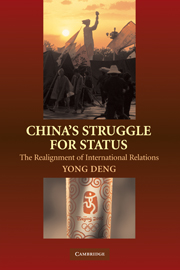Book contents
- Frontmatter
- Contents
- Figure and Tables
- Preface
- 1 Introduction
- 2 International Status and Chinese Foreign Policy
- 3 Negotiating the Human Rights Standard
- 4 Reacting to “China Threat Theories”
- 5 Strategic Partnerships with Russia, the European Union, and India
- 6 Independent Rivalry with Japan
- 7 Rediscovering Asia and Africa: The Multilateral Turn
- 8 Taiwan and China's Rise
- 9 China's Foreign Relations and the Emerging Great-Power Politics
- Index
5 - Strategic Partnerships with Russia, the European Union, and India
Published online by Cambridge University Press: 05 September 2012
- Frontmatter
- Contents
- Figure and Tables
- Preface
- 1 Introduction
- 2 International Status and Chinese Foreign Policy
- 3 Negotiating the Human Rights Standard
- 4 Reacting to “China Threat Theories”
- 5 Strategic Partnerships with Russia, the European Union, and India
- 6 Independent Rivalry with Japan
- 7 Rediscovering Asia and Africa: The Multilateral Turn
- 8 Taiwan and China's Rise
- 9 China's Foreign Relations and the Emerging Great-Power Politics
- Index
Summary
A notable achievement in China's diplomacy is its strategic partnerships with Russia (from 1996), the European Union (EU) (2003), and India (2005). From Beijing's perspective, “strategic partnership” connotes mutual acceptance of the partner states' importance to each other and to the world at large. The characterization thus signals a partner's political willingness to recognize China's legitimate rise, to manage areas of disagreement in order to steadily improve the overall bilateral relationship, and if possible to enhance coordination in promoting their common preferences in the international arena. However, just as each partnership has its own qualifier, in reality each of China's dyadic relationships has its own difficulties and limits as well as a distinctive set of dynamics.
There exists an impressive literature on the unusual relationship between Russia and China, focusing in particular on the history of the former's interaction with the latter. Many observers have underscored the problems and fragilities of their ties, and some have thus predicted an imminent disentanglement of their strategic partnership. Others have reduced the partnership to essentially an arms deal, beyond which there is little substance. Still, some analysts have viewed the new ties with alarm. Similarly, confusions abound over the meanings of China's strategic partnerships with the EU and India.
This chapter takes a fresh look at Sino-Russian ties and compares them with the other two more recent dyads to gain insights into China's approach to great-power politics in general.
- Type
- Chapter
- Information
- China's Struggle for StatusThe Realignment of International Relations, pp. 128 - 166Publisher: Cambridge University PressPrint publication year: 2008



